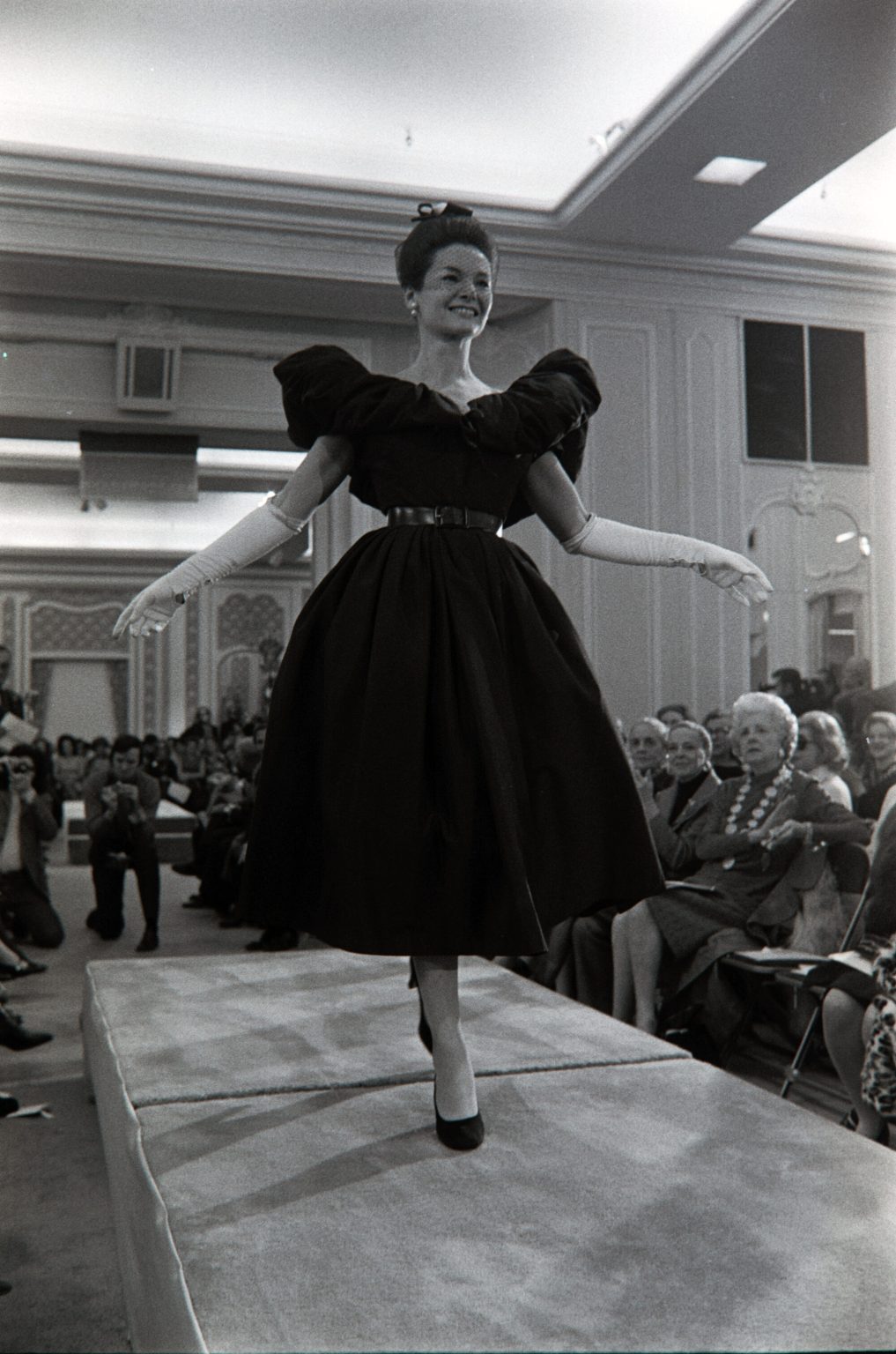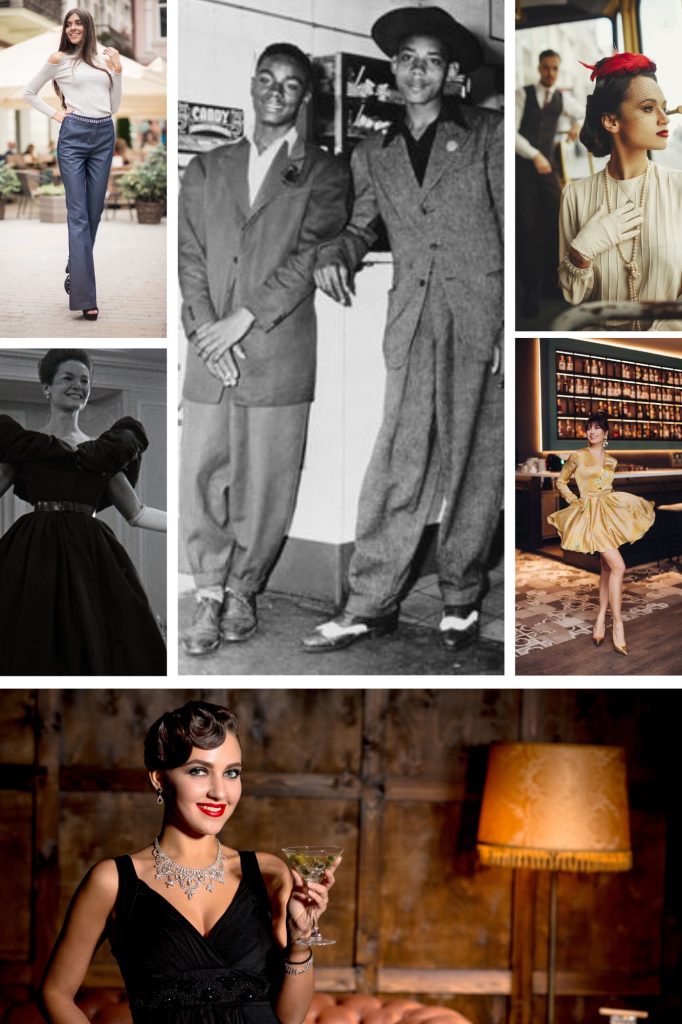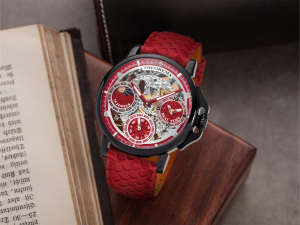“In one hundred years, fashion accelerated through more transformations than in the previous millennium, as if catching up with the speed of human dreams.”
Dinis Guarda

The 20th century compressed fashion evolution into unprecedented acceleration. Each decade brought distinctive styles whilst technological, social, and cultural revolutions continuously reshaped clothing’s role in human expression and reflected the century’s rapid social, technological, and cultural transformations. The century saw significant changes, particularly with the rise of iconic designers and fashion houses that established creative leadership whilst democratising access to fashionable dress through mass production.
The century opened with the Gibson Girl ideal (1900s-1910s), characterised by the S-bend silhouette that emphasised both bosom and hips whilst constraining the waist to impossible narrowness. This style represented the last gasp of Victorian fashion ideals before World War I accelerated changes toward practical dress that acknowledged women’s expanding social roles. The war’s demands for practical clothing began fashion’s liberation from purely decorative function.
The 1920s witnessed fashion revolution through flapper styles that gained popularity among women seeking to express newfound social and political freedoms. The decade’s drop-waisted dresses, bobbed hair, and cosmetic enhancement represented conscious rejection of Victorian feminine ideals, embracing modernity through fashion choices that proclaimed independence and equality. This was fashion as political statement, using dress to declare social transformation.
The Great Depression (1930s) brought practical and military-inspired styles that demonstrated fashion’s adaptability to economic hardship whilst maintaining aesthetic sophistication. Designers learned to create elegance through cut and line rather than expensive materials, establishing principles of economical luxury that influenced fashion throughout the century. The 1940s post-war period saw a mix of styles, including the Zoot Suit and more casual American styles that reflected the country’s emerging global cultural leadership.
Christian Dior’s New Look (1950s) proved highly influential, characterised by nipped-in waists and full skirts that re-established feminine silhouettes after wartime practicality. The New Look marked a turning point in the history of fashion and set the course for post-war fashion. This style represented fashion’s capacity for dramatic reinvention, using clothing to proclaim optimism and prosperity whilst re-establishing traditional gender roles through exaggerated feminine display.

Christian Dior’s New Look
The cultural revolutions of the 1960s-1970s brought bohemian and flowy styles, with bell-bottoms and denim becoming prominent symbols of generational rebellion. These decades established youth culture as primary fashion influence, democratising style through casual wear that rejected formal dress codes whilst embracing comfort and self-expression over social conformity.
The 1980s embraced power dressing and bold, vibrant styles that reflected the decade’s economic optimism and expanding professional opportunities for women. Fashion became armour for corporate success, with shoulder pads and structured silhouettes creating visual authority that supported women’s advancement in traditionally male-dominated professions.
The 1990s brought minimalism and grunge styles that emerged from alternative culture, reflecting shifts in societal attitudes toward authenticity, environmental consciousness, and rejection of conspicuous consumption. These styles demonstrated fashion’s capacity to find beauty in simplicity whilst expressing cultural criticism through deliberately anti-fashion approaches.
More Contents:
baroque brilliance and rococo romance 1600-1789
Belle Époque to War
1900s-1910s: The Gibson Girl look with a S-bend silhouette was popular. The period established many modern fashion principles whilst the First World War accelerated changes toward practical dress.
Jazz Age Liberation
1920s: Androgynous flapper styles gained popularity among women. This decade revolutionised female fashion, establishing principles of movement and liberation that continue to influence contemporary design.
Depression and War
1930s: Practical and military-inspired styles emerged due to the Great Depression. 1940s: The post-war period saw a mix of styles, including the Zoot Suit and more casual American styles. These decades proved fashion’s adaptability to social and economic pressures.
Post-War Revolution
1950s: Dior’s New Look was highly influential, characterized by a nipped-in waist and full skirt. This decade re-established fashion’s role in expressing optimism and prosperity.
Cultural Rebellion
1960s-1970s: Bohemian and flowy styles were popular, with bell-bottoms and denim being prominent. These decades established youth culture as a primary fashion influence.
Power and Minimalism
1980s: Power dressing and bold, vibrant styles were in vogue. 1990s: Minimalism and grunge styles emerged, reflecting a shift in societal attitudes. These decades explored fashion’s relationship with professional identity and cultural rebellion.
Key Benchmarks by Decade
| Decade | Defining Style | Cultural Context | Fashion Innovation |
| 1900s | Gibson Girl | Industrial prosperity | S-bend corsetry |
| 1910s | Wartime practicality | World War I | Simplified silhouettes |
| 1920s | Flapper revolution | Jazz Age liberation | Drop-waist dresses |
| 1930s | Depression functionality | Economic hardship | Practical elegance |
| 1940s | Utility fashion | World War II | Fabric rationing adaptations |
| 1950s | New Look femininity | Post-war optimism | Structured undergarments |
| 1960s | Youth revolution | Cultural rebellion | Mini skirts, mod styles |
| 1970s | Bohemian diversity | Counterculture movement | Ethnic influences |
| 1980s | Power dressing | Economic expansion | Shoulder pads, bold colours |
| 1990s | Grunge minimalism | Alternative culture | Deconstructed aesthetics |
- Dinis Guarda with Jasmeen Dugal
Dinis Guarda is an author, academic, influencer, serial entrepreneur, and leader in 4IR, AI, Fintech, digital transformation, and Blockchain. Dinis has created various companies such as Ztudium tech platform; founder of global digital platform directory businessabc.net; digital transformation platform to empower, guide and index cities citiesabc.com and fashion technology platform fashionabc.org. He is also the publisher of intelligenthq.com, hedgethink.com and tradersdna.com. He has been working with the likes of UN / UNITAR, UNESCO, European Space Agency, Davos WEF, Philips, Saxo Bank, Mastercard, Barclays, and governments all over the world.
With over two decades of experience in international business, C-level positions, and digital transformation, Dinis has worked with new tech, cryptocurrencies, driven ICOs, regulation, compliance, and legal international processes, and has created a bank, and been involved in the inception of some of the top 100 digital currencies.
He creates and helps build ventures focused on global growth, 360 digital strategies, sustainable innovation, Blockchain, Fintech, AI and new emerging business models such as ICOs / tokenomics.
Dinis is the founder/CEO of ztudium that manages blocksdna / lifesdna. These products and platforms offer multiple AI P2P, fintech, blockchain, search engine and PaaS solutions in consumer wellness healthcare and life style with a global team of experts and universities.
He is the founder of coinsdna a new swiss regulated, Swiss based, institutional grade token and cryptocurrencies blockchain exchange. He is founder of DragonBloc a blockchain, AI, Fintech fund and co-founder of Freedomee project.
Dinis is the author of various books. He has published different books such “4IR AI Blockchain Fintech IoT Reinventing a Nation”, “How Businesses and Governments can Prosper with Fintech, Blockchain and AI?”, also the bigger case study and book (400 pages) “Blockchain, AI and Crypto Economics – The Next Tsunami?” last the “Tokenomics and ICOs – How to be good at the new digital world of finance / Crypto” was launched in 2018.
Some of the companies Dinis created or has been involved have reached over 1 USD billions in valuation. Dinis has advised and was responsible for some top financial organisations, 100 cryptocurrencies worldwide and Fortune 500 companies.
Dinis is involved as a strategist, board member and advisor with the payments, lifestyle, blockchain reward community app Glance technologies, for whom he built the blockchain messaging / payment / loyalty software Blockimpact, the seminal Hyperloop Transportations project, Kora, and blockchain cybersecurity Privus.
He is listed in various global fintech, blockchain, AI, social media industry top lists as an influencer in position top 10/20 within 100 rankings: such as Top People In Blockchain | Cointelegraph https://top.cointelegraph.com/ and https://cryptoweekly.co/100/ .
Between 2014 and 2015 he was involved in creating a fabbanking.com a digital bank between Asia and Africa as Chief Commercial Officer and Marketing Officer responsible for all legal, tech and business development. Between 2009 and 2010 he was the founder of one of the world first fintech, social trading platforms tradingfloor.com for Saxo Bank.
He is a shareholder of the fintech social money transfer app Moneymailme and math edutech gamification children’s app Gozoa.
He has been a lecturer at Copenhagen Business School, Groupe INSEEC/Monaco University and other leading world universities.











